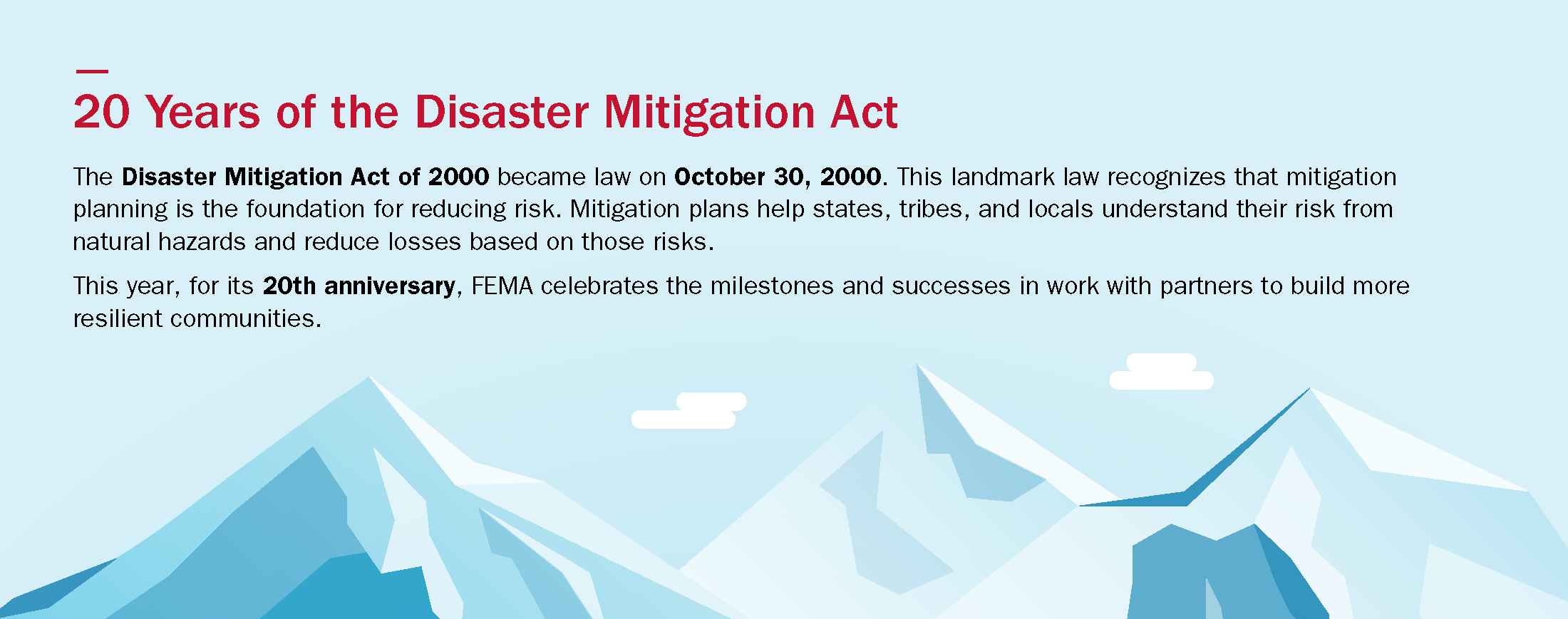Kathy Smith, AICP, Planning and Safety Branch Chief shares her views on the importance of the 20th anniversary of the Disaster Mitigation Act of 2000.
Communities have long engaged in planning for public safety and future growth. But Congress recognized the need to support a new kind of planning that would help state, tribal, territorial and local communities understand and reduce their vulnerability to natural hazards. This shift to focusing on pre-disaster planning was made formal in the Disaster Mitigation Act of 2000. This law was signed on Oct. 30, 2000, and amended the Robert T. Stafford Disaster Relief and Emergency Assistance Act (Stafford Act). FEMA is celebrating the anniversary and legacy of the Disaster Mitigation Act of 2000 throughout October and November.
Before the act was signed, emergency managers’ planning usually focused on preparing for and responding to disasters, which help people during hazard events. After the act passed, emergency managers began using a more proactive planning process. Leading their communities through that process resulted in FEMA-approved hazard mitigation plans. This planning was aimed at reducing the impacts of disasters before they occurred. Emergency managers began to use a more holistic, collaborative process for hazard mitigation plans. They involved a wider range of partners, from sectors such as housing and infrastructure. Mitigation plans brought together people from emergency management and community development. They encouraged community-specific blueprints for proactively reducing risks and vulnerabilities. This kind of plan is required to receive certain types of FEMA assistance. But participants found that the plans could be useful for much more than that.
As with most new initiatives, the first iteration of mitigation plans simply tried to meet the requirements in regulation and FEMA’s “Blue Book” (2004). The plans’ contents rarely reflected each community’s unique needs. However, with a requirement for updates every five years, future versions grew and evolved with the communities and were refocused on priorities to match the times. Today, these are foundational documents to help ensure disaster responses are locally executed, managed by the state, territory or tribal governments, and federally supported.
Through the years, FEMA provided more guidance and training. This helped states, locals, tribes and territories develop more effective hazard mitigation plans. Lessons learned across the nation were paired with hands-on assistance and how-to resources to help communities plan. The result is hazard mitigation planning that is more inclusive and plans with actionable strategies. The plans became tools to prepare and protect states, tribes, territories and local communities from the impact of disasters and natural hazard events.
Twenty years later, many communities are updating their hazard mitigation plan for the fourth or fifth time. Increasingly, they are integrating elements of mitigation planning with other plans, such as comprehensive or economic development plans. Local communities are using them to decide where and how to build. The plans include using current disaster-resistant building codes. Communities are adding land use, wildfire protection, climate adaptation and fields such as public health to their mitigation planning. Take Massachusetts, which combined its hazard mitigation and climate adaptation plans into one strategy. Or Manitou Springs, Colorado, which uses hazard mitigation as a factor in its growth and development choices. This is a testament of the power of planning to reduce risk.
FEMA’s National Mitigation Planning Program celebrates this landmark legislation. As we do so, we work to elevate and support effective planning. We engage with partners early and often, support plan integration and implementation of actions using a wide range of public and private resources. Effective planning leads to completed mitigation projects, including non-structural actions. FEMA continues to help communities as they work to become safer and more resilient. To see a clear picture of the long-term impact nationwide, take a look at the timeline.

FEMA is celebrating the anniversary and legacy of the Disaster Mitigation Act of 2000 this October and November. For more information about the law, visit the FEMA website. For resources to support mitigation planning and your hazard mitigation plan, visit the Hazard Mitigation Planning page.
In addition, the 2020 Fiscal Year funding cycle for the Hazard Mitigation non-disaster grants is accepting applications until Jan. 29, 2021. As a FEMA-approved Hazard Mitigation Plan is required for funding, review the eligible projects for funding for a Flood Mitigation Assistance and the new pre-disaster mitigation program Building Resilient Infrastructure and Communities.


